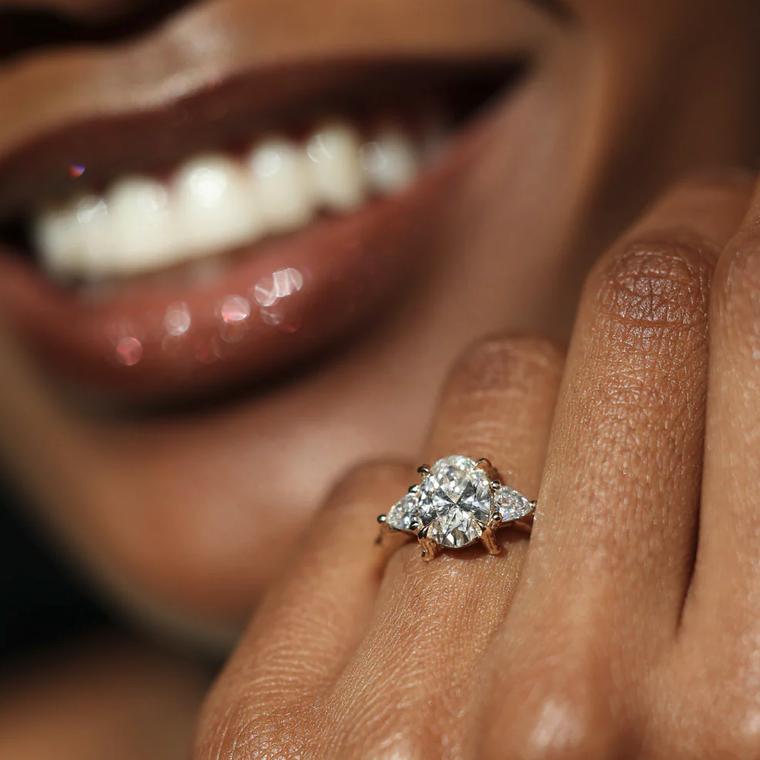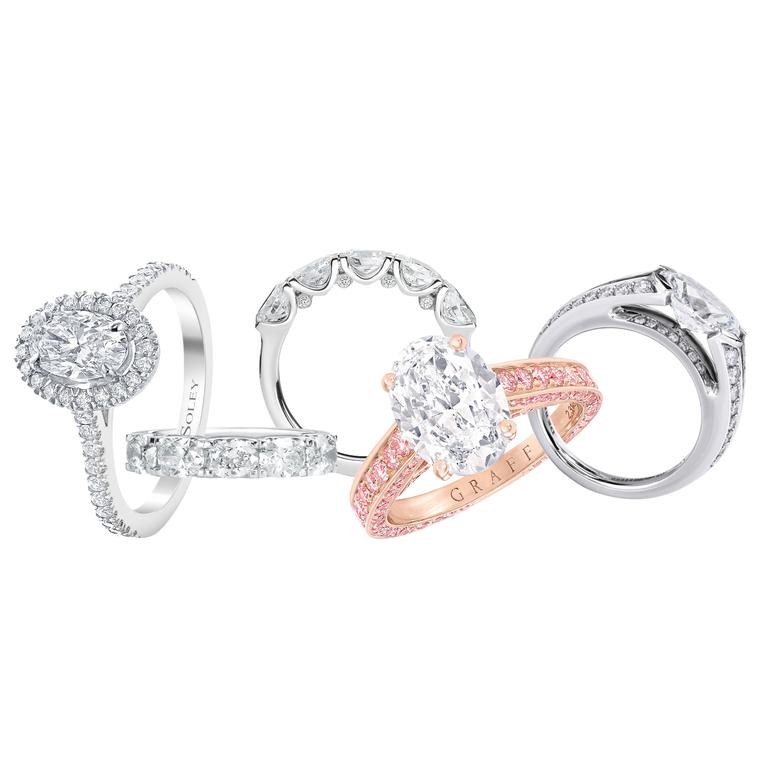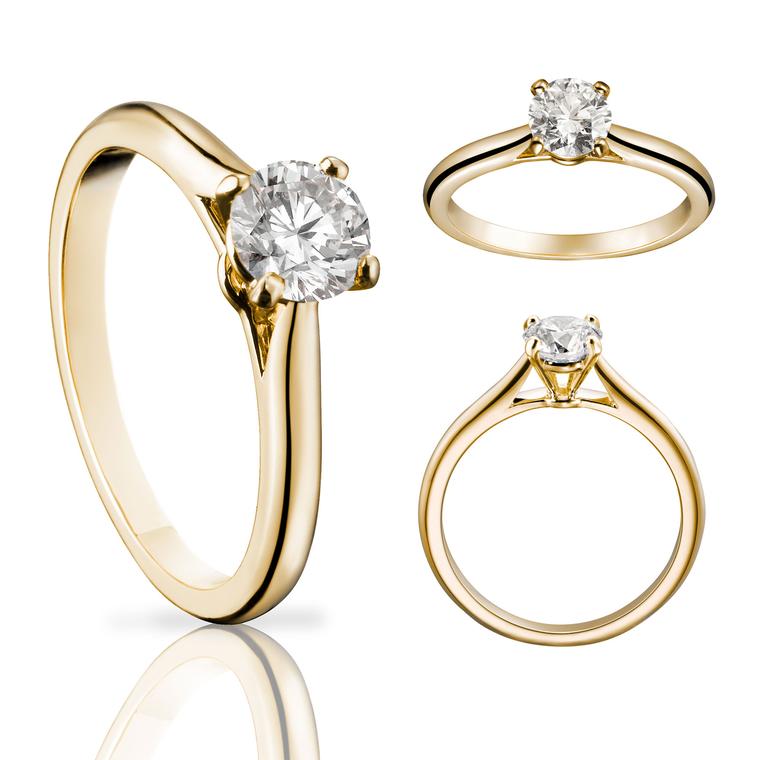Transcript
| 14 oct 2014Maria Doulton: Buying a diamond is a big and important decision, so I hope to explain to you what's behind the famous four Cs. It's all about cut, clarity, colour and carats, and where better to come than Graff Diamonds, which has handled some of the most important diamonds of our time, as well as offering an array and choice like very few others can.
The first 'C' to think about when choosing a diamond is the cut. Now, the cut determines the shape of the diamond as well as its brilliance, because different cuts have differing numbers of facets, and it's these facets that give the diamond its sparkle. Think of facets like reflective surfaces that shine light through the diamond.
There are many different diamond cuts to choose from, so I'll tell you the most important points for each one. The round brilliant cut is the most popular cut for engagement rings, and I think you can see why; it's because it gives a nice shape on the hand, and it has an awful lot of brilliance as well, thanks to its 57 facets.
The oval shape is in fact a variant of the brilliant cut, so it's got lots of brilliance and sparkle, but it suits petite hands a little bit better.
The pear shape is a really feminine cut I think, and it works beautifully on petite hands. Because it's got the pointed end, it has the effect of elongating the fingers.
The antique style of the cushion cut has gained favour in the past few years, and I think it's because it's that nice combination of a very precise, modern cut, but with a sort of old-fashioned air about it.
My favourite has to be the emerald cut, because it's very, very traditional. It's got these long, clean lines, which make it have a sort of deep shine as opposed to a brighter sparkle, and the emerald cut suits hands like mine, which are quite large and with long fingers, so that's the one for me.
Once you've decided the cut of the diamond, it's really important that you make sure that you buy a good-quality cut, because it's the precision of the cut that determines how much brilliance you will get from a diamond. Now, Graff will only sell cuts that are from excellent to good, which means that you are making the very most of that investment.
'C' is for clarity, and this refers to how clean or clear the diamond is. It goes a lot more than just skin deep. To determine how clean a diamond is, you'll need one of these, which is a jeweller's loop, and this magnifies by ten times, so any grading that you find on a diamond certificate refers to what is visible with a magnification of ten times.
The flaws that occur in a diamond have two names, so if they're inside the diamond, they're called inclusions, and if they're on the surface, they're called blemishes, so you need to look out for those two different types. Inclusions are more visible in some cuts than others, and the most forgiving cut for inclusions is the cushion cut, whereas the emerald is quite the opposite, and its long, clean lines that shine right into the heart of the diamond mean that there is no room for any flaws.
The clarity of a diamond is graded on a scale, and right at the bottom is imperfect, and it goes to the top grading, which is flawless; the most desirable. This is of course determined by how many blemishes or inclusions are within that diamond.
After internally flawless comes VVS, which stands for very, very slightly included, and then just after that is VS, which stands for very slightly included. Now, a company like Graff, who only sells the very best quality, will not go below VS - very slightly included - so use that as a benchmark; don't go below VS1 or 2 if you can avoid it.
Another important 'C' to consider when buying a diamond is colour, and if it's a white diamond, ironically what you're looking for is total lack of colour. Now, the top grading for a white diamond is D, and then it goes down alphabetically right to Z.
The way that they decide on the grading for the colour of a diamond is to look at it upside down, so that eliminates the sparkle factor, against white paper, and then they check that against a chart of colours, so it's all scientific and it's determined by an expert.
If you're considering buying a single-stone ring, the general recommendation, and that of Graff as well, is to not go below G, because any point below that then you do start to get a slightly less clear white colour.
Not to be forgotten is another vital 'C', and that is of course carat. Carat refers to the weight of the stone, and one carat is one fifth of a gram. Now, you don't need me to tell you that a large diamond is more valuable than a small diamond, but it is interesting to know that large diamonds are of course rarer, so this means that a five-carat diamond is many times more valuable than a one-carat diamond; it isn't simply five times more valuable.
Not all diamond cuts look the same size even if they are the same carat weight, and a brilliant cut is the one that punches above its weight because of its diameter; it looks bigger than a similar-carat emerald cut. If you're going for the big look on the finger, the brilliant cut will do it every time.
Now, for a single-stone ring, for an engagement ring, I think don't go below one carat, because you really want to have that wow factor. Carat and size is not everything, so you always have to balance that with the other three Cs, and come to the ideal choice that works just right for you. Bear in mind that a well-cut diamond will always look better than a lesser-quality cut, even if it's the same carat weight.
I really do suggest that you come to Graff, because here you will see the most amazing range of sizes and cuts of diamonds, all of them top quality, knowing that they have been cut by the best in the business. For generations, Graff has been involved in the diamond business, and it is one of the few companies that can claim to be involved in the life of a diamond, right through from buying the rough, to cutting and polishing, and of course setting the diamond in its own workshops. This means that Graff are involved in every single stage of what makes a diamond special.
Graff has handled some of the most exceptional stones of our times. I'm talking about those enormous, hugely valuable, multi-million-pound diamonds that make the headlines, and it's this immersion in the world of diamonds that I think shines through in every single one of its jewels, right through to the smallest engagement ring.
To start your journey of buying a diamond, you really can't do much better than coming to Graff.
If you want to know all that is happening in the world of jewellery and watches, visit my website at Thejewelleryeditor.com







